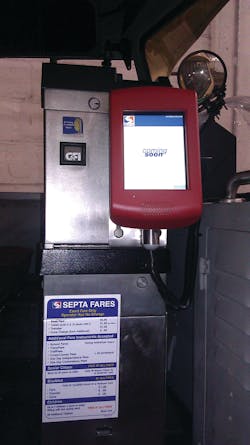Several years ago, leaders within the Southeastern Pennsylvania Transportation Authority (SEPTA) decided they needed to upgrade the agency’s fare collection system.
The system, with its old fare boxes, turnstyles and issuance of tickets for the commuter rail system was deemed venerable, but wearing out. So when system leaders decided to look into a new fare collection system that could implement new pricing to meet customer demands, they decided it was time to take fare technology to the next generation.
“Riding SEPTA in the future won’t be like taking a ride at an amusement park,” said John McGee, chief officer of new payment technologies for SEPTA. “You won’t need to buy a special ticket or a pass. You’ll be able to use what’s in your pocket or in your wallet.”
SEPTA issued a $129 million contract to Xerox in 2011 to create a new open fare system allowing customers to pay using a contactless smart card, personal credit card, debit card, or mobile phone with contactless technology to pay for fares by fall of 2014.
With the new fare system, leaders say it will allow fare cost adjustments, create efficiencies and save on operating costs. McGee said 10 to 12 percent of SEPTA riders pay with cash, but that number is expected to drop by half with the new fare system.
Julie Green, director of revenue systems for LTK Engineering Services, said the new contactless cards and mobile ticketing devices are first being adopted by the bigger agencies in the U.S., which can make the massive initial capital investment into the technology. But as the systems are put in place it will later allow for midsized agencies to begin implementing the upgrades in coming years.
While more traditional smart card systems allow for customers to buy cards with set rides or dates on them, Green said agencies no longer want to issue their own currencies and are looking into open fare systems to allow riders to link to their own bank accounts, allowing for them to pay with their own currency and protect the agency from fraud.
“I think transit agencies have been cash starved for many years and I think most of them have held back in investing in this for a long time,” Green said. “But now they’re now forced to do it because their equipment is tapped out.”
The Chicago Transit Authority has been working with Cubic Transportation Systems on the implementation of its new Ventra card, a contactless card for riders boarding the system. The nearly $500 million venture is expected to save the authority $5 million per year in costs and will work with the Pace Suburban Bus Service, which operates in suburban Chicago.
Eric Reese, director of revenue for CTA, said the agency made the change in order to get away from issuing its own fare media, increase it accessibility in the Chicagoland area and makes it easier for customers to use the system. The Ventra card will act like a prepaid debit card and Reese said unlike traditional fare cards, possessors of the cards will be able to use them to purchase other goods at stores.
“This system meets the CTA president’s vision and Mayor (Rahm) Emanuel’s vision of a world class transit system and increasing ridership on CTA,” Reese said.
A tough call
Hugh Thomas, CEO of Sky Highways, a creator of software allowing transit agencies to use mobile devices for fare collection, said there are a variety of different options agencies can opt for when using mobile device ticketing, such as having phones display pictures of tickets, using QR codes, moving images and phones using near field radio frequency identification (RFID) technology, which allows the phone to work as a smart card by downloading an app for the device. But if agencies are not careful in their technology choices, they may chose an option to only serve 10 percent of its riders while ignoring the needs of 90 percent of its customers.
“I think it’s important to recognize that the smart phone revolution is still in its early stages,” he said. “I think it’s fair to say there’s a lot of industry evolution taking place as we speak.”
A major issue with mobile ticketing in the U.S. is a lot of transit agencies have already installed their own proprietary equipment, meaning different software or equipment is needed depending on where you’re trying to use transit. Thomas said there has been talk of standardization, but it’s a difficult issue to tackle given the amount of agencies out there being governed by different bodies and the amount of vendors using their own equipment.
“It’s not quite the panacea people think,” Thomas said. “Just because you pay for bus fare using it in Atlanta doesn’t mean you can in Chicago.”
Making the leap to a smart card system might be a great idea, but Green said it’s also an expensive one, which may make it tougher for smaller agencies to invest and incur the ongoing operational costs. But smaller systems near larger systems are aided in the transition when their big neighbors upgrade their technology.
McGee said part of the deal with Xerox gives SEPTA a license of the equipment within Pennsylvania and neighboring areas outside of the state, so leaders have begun talking with small and midsized systems to upgrade their equipment in the future.
“Quite frankly, the smaller or midsized agencies can invest in the infrastructure or readers, but they can’t invest in the back end of the system,” he said. “It’s just too large of a jump for them given the other needs they have, but we see an opportunity to enable them to go the way of the smart cards in the years ahead, so we’re beginning to reach out to our sister agencies and smaller agencies across the commonwealth.”
An end of the traditional card
Systems with smart card fares are now finding even more ways to reach customers without actually making them pick up a transit fare card.
Robert Creedon, deputy director of fare systems for the Massachusetts Bay Transportation Authority, said blank Charlie Cards — which are that system’s smart cards — are given to Boston Public Schools and colleges such as Massachusetts Institute of Technology and Northeastern University, which are then used as student IDs, giving the cards dual purpose. He said some hospitals also had interest in having employee IDs work as smart cards for the system and other businesses have also inquired about having their employee IDs double as fare cards.
In 2011, the Port Authority of Allegheny County began a program with the University of Pittsburgh where university IDs for staff, students and faculty doubled as a smart fare card for entering transit there as part of the U-Pass program there. Prior to the smart cards, students used the IDs in a flash pass system to pay fare like non-student pass holders and by testing the new cards on the 40,000 people associated with the university, it gave the agency an opportunity to have a solid sample size for the entire system.
“Essentially one of the issues inherent with the flash pass system is fraud,” said Heather Pharo, spokesperson for the agency. “Whether it’s someone who may be counterfeiting one of our regular passes or someone who is using beyond when they should.”
Under the old system, students who dropped out or no longer students at Pittsburgh would be able to continue using the ID without operators knowing it was invalid. Once the change to the smart card ID occurred, Pharo said the card could be deactivated within a day.
The new ConnectCard being rolled out by the agency could also be used for employers or other schools wanting to take part in a transit program.
“After all of this is implemented, it allows for the board to take another look at new products of fares,” Pharo said.
With these new initiatives and fare offerings, transit agencies upgrading their equipment are expecting big payoffs in terms of ridership growth. SEPTA is at its highest ridership level in 23 years, McGee said, but research shows there will definitely be measurable ridership gains with the new open fare system because infrequent or new riders will not have to find out how to pay and take the system. While doing research and focus groups, he said there is excitement amongst residents, which tends to grow ridership.
Smart card and RFID technology will continue to evolve and offer new options for transit agencies to explore. And those making the investments now are confident they’re headed in the right direction.
“At this point it’s a heavy lift for us because we’re kind of at the forefront of the open payment scheme, but we’re confident of the direction we’re going because we truly believe that instead of customers just paying for transit, we should assume the same role as paying for any other good or service,” McGee said. “We see ourselves evolving to the role of the merchant for folks to use repeatedly.”
About the Author
Joe Petrie
Associate Editor
I came to Mass Transit in 2013 after spending seven years on the daily newsbeat in southeastern Wisconsin.
Based in Milwaukee, I worked as a daily newspaper reporter with the Waukesha Freeman from 2006-2011, where I covered education, county and state government. I went on to cover courts for Patch.com, where I was the main courts reporter in the Metro Milwaukee cluster of websites.
I’ve won multiple awards during the course of my career and have covered some of the biggest political events in the past decade and have appeared on national programs.
Having covered local government and social issues, I discovered the importance of transit and the impact it can have on communities when implemented, supported and funded.

